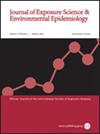SARS-CoV-2的空气、地表和废水监测;建筑环境中COVID-19检测的多模式评估。
IF 4.7
3区 医学
Q2 ENVIRONMENTAL SCIENCES
Journal of Exposure Science and Environmental Epidemiology
Pub Date : 2025-03-01
DOI:10.1038/s41370-025-00757-3
引用次数: 0
摘要
背景:传染性生物的环境监测具有巨大的希望,通过早期发现减少室内空间的人际传播。目的:在本研究中,我们确定了废水、室内高接触表面、室内空气和屋顶排风采样方法在最近诊断为COVID-19的居民居住的真实世界建筑物中检测SARS-CoV-2的适用性和局限性。方法:对某新型冠状病毒肺炎隔离宿舍已知的每日人口普查波动情况,同时采用室内地面采样、排风采样和废水监测3种24小时环境监测技术进行检测。此外,我们评估了放置在大容量大厅的气溶胶采样器每天多次检测SARS-CoV-2的能力。结果:我们的研究显示,COVID-19确诊阳性人数的增加以及他们估计的人类病毒载量与屋顶排气气溶胶样本(p = 0.0413)、废水样本(p = 0.0323)和室内高接触表面(p)中检测到的病毒载量的统计学显著增加有关。我们得出的结论是,每天(24小时)的监测方法,屋顶排气,室内高接触表面和废水,为建筑物所有者/操作员提供了有用的检测信号。此外,我们证明了排气采样可以提供基于通风排气区域的空间分辨信号。此外,我们发现室内大堂空气采样可以提供在短时间采样期间(例如2-4小时)有用的临时解析信号,即使是在被诊断为COVID-19的居住者间歇性入住的情况下。影响:我们的研究表明,气溶胶取样可以在很短的入住时间内在现实世界的大厅环境中检测到COVID-19阳性个体。我们展示了屋顶排气气溶胶、表面和废水环境监测在监测建筑物居住者病毒载量方面的有效性,无论是在建筑物规模上还是在通风区域级别上对气溶胶的分辨率上。我们为研究人员、卫生官员和建筑物管理人员提供可操作的数据,以确定哪种监测方法最适合他们的建筑物或研究。本研究涉及流行病学、暴露科学、生物监测、病毒学、公共卫生、健康建筑设计与管理等领域。本文章由计算机程序翻译,如有差异,请以英文原文为准。

Air, surface, and wastewater surveillance of SARS-CoV-2; a multimodal evaluation of COVID-19 detection in a built environment
Environmental surveillance of infectious organisms holds tremendous promise to reduce human-to-human transmission in indoor spaces through early detection. In this study we determined the applicability and limitations of wastewater, indoor high-touch surfaces, in-room air, and rooftop exhaust air sampling methods for detecting SARS-CoV-2 in a real world building occupied by residents recently diagnosed with COVID-19. We concurrently examined the results of three 24-hour environmental surveillance techniques, indoor surface sampling, exhaust air sampling and wastewater surveillance, to the known daily census fluctuations in a COVID-19 isolation dormitory. Additionally, we assessed the ability of aerosol samplers placed in the large volume lobby to detect SARS-CoV-2 multiple times per day. Our research reveals an increase in the number of individuals confirmed positive with COVID-19 as well as their estimated human viral load to be associated with statistically significant increases in viral loads detected in rooftop exhaust aerosol samples (p = 0.0413), wastewater samples (p = 0.0323,), and indoor high-touch surfaces (p < 0.001)). We also report that the viral load detected in lobby aerosol samples was statistically higher in samples collected during presence of occupants whose COVID-19 diagnostic tests were confirmed positive via qPCR compared to periods when the lobby was occupied by either contact-traced (suspected positive) individuals or during unoccupied periods (p = 0.0314 and <2e−16). We conclude that each daily (24h) surveillance method, rooftop exhaust air, indoor high-touch surfaces, and wastewater, provide useful detection signals for building owner/operator(s). Furthermore, we demonstrate that exhaust air sampling can provide spatially resolved signals based upon ventilation exhaust zones. Additionally, we find that indoor lobby air sampling can provide temporally resolved signals useful during short duration sampling periods (e.g., 2-4 hours) even with intermittent occupancy by occupants diagnosed with COVID-19.
求助全文
通过发布文献求助,成功后即可免费获取论文全文。
去求助
来源期刊
CiteScore
8.90
自引率
6.70%
发文量
93
审稿时长
3 months
期刊介绍:
Journal of Exposure Science and Environmental Epidemiology (JESEE) aims to be the premier and authoritative source of information on advances in exposure science for professionals in a wide range of environmental and public health disciplines.
JESEE publishes original peer-reviewed research presenting significant advances in exposure science and exposure analysis, including development and application of the latest technologies for measuring exposures, and innovative computational approaches for translating novel data streams to characterize and predict exposures. The types of papers published in the research section of JESEE are original research articles, translation studies, and correspondence. Reported results should further understanding of the relationship between environmental exposure and human health, describe evaluated novel exposure science tools, or demonstrate potential of exposure science to enable decisions and actions that promote and protect human health.

 求助内容:
求助内容: 应助结果提醒方式:
应助结果提醒方式:


